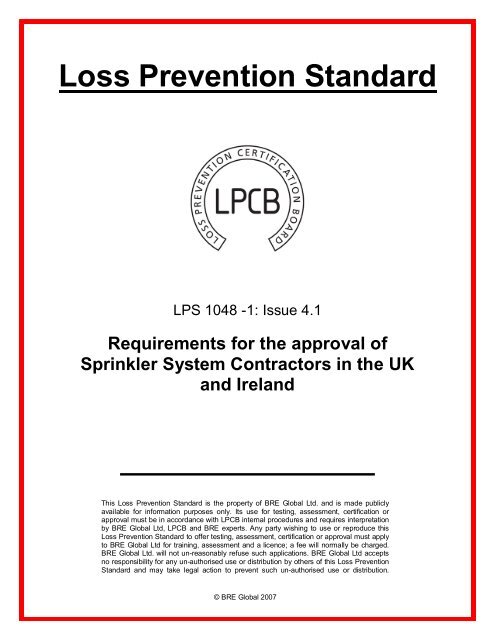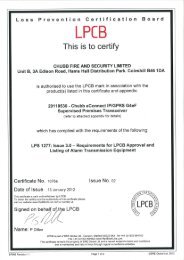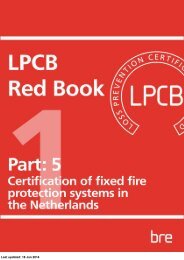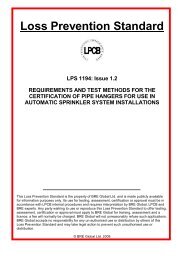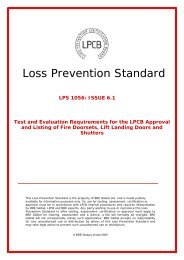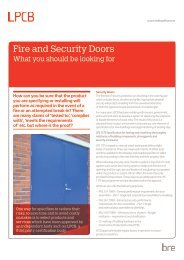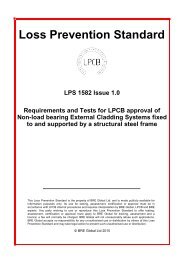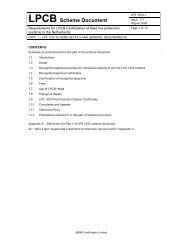LPS 1048 - RedBookLive
LPS 1048 - RedBookLive
LPS 1048 - RedBookLive
Create successful ePaper yourself
Turn your PDF publications into a flip-book with our unique Google optimized e-Paper software.
Issue: 4.1<strong>LPS</strong> <strong>1048</strong>-1LOSS PREVENTION STANDARDDate: May 2007 Page 2 of 26PARTICIPATING ORGANISATIONSThis standard was approved by the BRE Global Governing Body and Working Group C. Thefollowing organisations participated in the preparation of this standard:-Association for Specialist Fire Protection (ASFP)Association of British Insurers (ABI)Association of Insurance SurveyorsBAA PlcBritish Automatic Fire Sprinkler Association (BAFSA)British Property Federation (BPF)Construction Industry Council (CIC)Construction Products AssociationCo-op BankingFire Industry Association (FIA)Home Builders Federation (HBF)Homes & Communities AgencyLend LeaseChief Fire Officers’ Association (CFOA)London Underground ltdNHBCRIBARICSRisktech LtdSustainability + ArchitectureSustainable by Design© BRE Global Ltd, 2007
Issue: 4.1<strong>LPS</strong> <strong>1048</strong>-1LOSS PREVENTION STANDARDDate: May 2007 Page 8 of 26Contractors wishing to gain approval at a higher level in the scheme, or to self-certificateadditional Categories of Work, must submit an application to LPCB, pay the appropriate feesand undergo an assessment.Where a Contractor operates design and installation work from more than one location, thenseparate approvals must be obtained for each. Regional offices undertaking only sales and/oremergency service work are not covered by this scheme.2.3 Use of LPCB MarksDetails of how the mark may be used can be found in publication PN 103.2.4 Change of Company Identity or ParticularsThe Contractor should promptly notify the LPCB of any changes relating to their compliancewith this scheme, including a change of company identity, legal entity, company registrationand/or location. The Contractor shall notify any changes using publication PN 112.2.5 CostsAll costs associated with <strong>LPS</strong> <strong>1048</strong>-1 assessments, surveillance visits, special visits,supervision and certification are borne by the Contractor. Charges will be made in accordancewith the LPCB Schedule of Fees current at the time.© BRE Global Ltd, 2007
Issue: 4.1<strong>LPS</strong> <strong>1048</strong>-1LOSS PREVENTION STANDARDDate: May 2007 Page 9 of 263. REQUIREMENTS FOR APPROVAL OF ALL CONTRACTORS3.1 Installation StandardsUnless otherwise required by the Client, all sprinkler systems must be designed in accordancewith the one of the installation standards listed in Appendix 1. Where the client’s specificationdoes not meet the minimum requirements of this scheme, the Contractor must not in any wayclaim or imply that the design or installation meets the requirements of this scheme and mustnot issue an <strong>LPS</strong> <strong>1048</strong> Certificate of Conformity.3.2 Management System RequirementsIn order to ensure that Automatic Sprinkler Installations meet and continue to meet therequirements of this scheme, Contractors are required to maintain full control of their design,supply of materials, pre-fabrication of sprinkler pipework, installation, commissioning andmaintenance processes through a management system audited by LPCB.If the Contractor requires LPCB ISO 9001 certification and listing, the management system willbe audited against the requirements of ISO 9001 and Guidance Note GN11. However, if theContractor does not require LPCB ISO 9001 certification and listing, they will be audited againstthe requirements of LPCB Publication PN111 – Generic Factory Production ControlRequirement, and Guidance Note GN11.Firms applying for Level 1 approval shall have a fully documented and operational qualitymanagement system meeting the requirements of ISO 9001 and GN11. To maintain <strong>LPS</strong> <strong>1048</strong>-1 approval, they shall obtain LPCB certification for their quality management system within 12months from issue of an <strong>LPS</strong> <strong>1048</strong>-1 approval certificate.Full details of our ISO 9001 certification process are set out in publication SD003 ‘QualityManagement System Certification Scheme’.The duration and frequency of the Management System audit visits is typically one day twiceper year. However, the actual frequency and duration depends on a number of factors includingsize of company and scope of activities.3.3 Contract RequirementsContractors will have satisfactorily completed a minimum number of projects or contracts inorder to enable LPCB to carry out a full technical review and site inspection of a sample of thesecontracts. The minimum numbers and types of contract for each level are given below. Forapproval purposes, each contract must be assessed as satisfactory by LPCB against therequirements of this scheme.© BRE Global Ltd, 2007
Issue: 4.1<strong>LPS</strong> <strong>1048</strong>-1LOSS PREVENTION STANDARDDate: May 2007 Page 13 of 26Note – The qualification requirements referred to in Table 2 may be waived up to 1 January2008 for the design competence reviews and 1 January 2009 for the inspection competencereview where the Contractor can demonstrate to the satisfaction of the LPCB that thepersonnel employed have the necessary levels of competence.3.6 Competency ReviewsThe competence review process, together with its associated examination formats,examination questions, model answers and marking regime are overseen by an examinationpanel.The examination panel comprises technical experts drawn from various organisations, such as:LPCB/BREInFiresTrade Organisation(s)3.7 Sub-contractingA Contractor cannot sub-contract work that they are not allowed to undertake at their currentapproval level in the <strong>LPS</strong> <strong>1048</strong>-1 scheme.The Contractor shall be fully responsible for the work of their sub-contractors.Where sub-contractors are used:• The quality of their designs, materials, equipment or workmanship is to be to the samestandard as that of the <strong>LPS</strong> <strong>1048</strong>-1 approved Contractor.• Service and maintenance activities will be carried out by directly employed personnel,or be sub-contracted to other <strong>LPS</strong> <strong>1048</strong>-1 approved Contractors. Where specialistequipment and plant is involved e.g. fire pumps, suction tanks, trace heating,alarm/indicating systems, the service and maintenance may be carried out by themanufacturer, their authorised agents or specialist companies.• All work undertaken by such sub-contractors is to be reviewed and verified by qualifiedstaff directly employed by the Contractor to ensure that the requirements of the schemeare met. Records are to be maintained for all work sub-contracted.3.8 EquipmentWhere available, all specialist fire protection equipment used by the Contractor will be LPCBapproved and procured directly from the manufacturer or his agent.Training in the use and service of this equipment will be obtained from the manufacturer or hisagent. All equipment will be used fully in accordance with manufacturer’s instructions, itsLPCB approval conditions, and the installation standard.The Contractor should, where available, only use spare parts obtained from the manufacturersor their approved agents.© BRE Global 2007
Issue: 4.1<strong>LPS</strong> <strong>1048</strong>-1LOSS PREVENTION STANDARDDate: May 2007 Page 14 of 263.9 Technical DataThe Contractor will:• have access to current technical data, including specifications, installation,commissioning and service/maintenance instructions from all manufacturers ofspecialist fire protection equipment installed or serviced.• make this information readily available to all necessary personnel, especially fieldoperations staff.• maintain computer software packages for hydraulic calculations to the versioncompliant with the installation standard in use.• carry out and record standardisation checks for hydraulic calculation packages on eachworkstation, where terminals are independent of a central server.3.10 Sprinkler Systems Inspection and MaintenanceThe Contractor will offer an inspection and maintenance service to customers in accordancewith the appropriate installation standard. The results of such inspections will be recorded anda copy provided to the building owner and/or occupier or agent.The results of periodic testing will be compared with the original system requirements e.g.installation design flow rates, pump ratings, air pressures, in-fill rates, etc. to confirm that thesystem continues to provide protection commensurate with the occupancy and/or hazard classof the premises under review.In the event that test results are found to be inadequate or that there are serious shortfalls insprinkler protection, the Contractor shall notify the building owner and/or occupier or agentwithin 7 days. Examples of such serious shortfalls would be: change of hazard class, storageheight not commensurate with density, unprotected areas, inadequate densities of discharge,pump performance shortfall, installation control valve un-serviceability, deterioration of town’smain or pumped water supply etc.3.11 Emergency ServiceThe Contractor will provide an effective 24-hour emergency service for customers to ensurethat appropriate remedial action can be undertaken on site within 24 hours.Service and maintenance engineers are to have access to a sufficient range of approved spareparts to resolve emergency call-out situations.3.12 Maintenance of CertificationCertification of the Contractor is maintained by regular audits by LPCB to ensure that therequirements of the scheme continue to be met (see Appendix 2 for further details).© BRE Global 2007
Issue: 4.1<strong>LPS</strong> <strong>1048</strong>-1LOSS PREVENTION STANDARDDate: May 2007 Page 15 of 263.13 <strong>LPS</strong> <strong>1048</strong> Certificates of ConformityAn <strong>LPS</strong> <strong>1048</strong> Certificate of Conformity shall be issued for each extension, alteration,installation and system carried out in accordance with the <strong>LPS</strong> <strong>1048</strong>-1 scheme requirementsand Guidance Note GN4.Certificates shall be completed in accordance with Guidance Note GN3.3.14 Distribution of <strong>LPS</strong> <strong>1048</strong> Certificates of Conformity<strong>LPS</strong> <strong>1048</strong> Certificates of Conformity will be issued to the following:• The building owner/occupier (requiring their representative’s signature)• LPCBand, where appropriate, secured to the installation control valve assembly.Where required and agreed by the Client, copies of the certificate may be issued to:• Building control• Fire brigade• Insurance CompanyIn the case of multi-tenancy buildings:a. The facilities management department orb. The Centre Manager (for shopping centres)Copies of the certificate are to be retained by:a. The Contractorb. The Supervising Body / LPCB Supervisory Service3.15 Annual ReturnsThe Contractor is to provide to LPCB details of the numbers of sprinkler heads and alarmvalves it has installed between January 1 st to December 31 st each year. Annual returns to bemade by 31 st July of each following year.© BRE Global 2007
Issue: 4.1<strong>LPS</strong> <strong>1048</strong>-1LOSS PREVENTION STANDARDDate: May 2007 Page 16 of 26Appendix 1 - List of acceptable installation standards and publications referred to:A1.1 Installation StandardsFor the purpose of this scheme document, Installation Standard will mean, as appropriate, thecurrent documents including the latest revisions of:a) LPC Rules for Automatic Sprinkler Installations (version 1), incorporating BS 5306:Part 2: 1990 - Specification for sprinkler systems, with LPC Technical Bulletins thatare in force at the time, orb) For Life Safety systems only, BS 5306: Part 2: 1990, incorporating LPC TechnicalBulletins 1, 2 and 20, providing no other Technical Bulletins are used to carry outthe design, orc) LPC Rules for Automatic Sprinkler Installations (version 2), incorporating BS EN12845 - Fixed fire fighting systems – Automatic sprinkler systems – Design,installation and maintenance, with LPC Technical Bulletins that are in force at thetime, ord) For Life Safety systems only, BS EN 12845, incorporating LPC Technical Bulletins201 and 202, providing no other technical bulletins are used to carry out the design,ore) BS 9251 - Sprinkler systems for residential and domestic occupancies – Code ofpractice, orf) NFPA 13 (excluding 13D and 13R), org) FM Global Property Loss Prevention Data Sheets (excluding Residential Datasheets).Note: Hybrid and individualised corporate or institutional specifications are not acceptable toLPCB for the purpose of certification.If a Contractor wishes to certificate to another standard or set of installation standards theyshould contact the LPCB.© BRE Global 2007
Issue: 4.1<strong>LPS</strong> <strong>1048</strong>-1LOSS PREVENTION STANDARDDate: May 2007 Page 17 of 26A1.2 Publications• Application form F 015• BRE Global – PN 100 – Complaints and Appeals Procedure• BRE Global – PN 101 – Terms & Conditions• BRE Global – PN 103 – Use of Marks• BRE Global – PN 112 – Notification of change of particulars• BS 5306: Part 2: 1990 – Specification for Sprinkler Systems• BS 9251 - Sprinkler systems for residential and domestic occupancies – Code of practice• BS EN 12845 - Fixed fire fighting systems – Automatic sprinkler systems – Design,installation and maintenance• Contract Log F543• GN3/<strong>LPS</strong> <strong>1048</strong>– Guidance Note for the completion of <strong>LPS</strong> <strong>1048</strong> Certificates ofConformity• GN4/<strong>LPS</strong> <strong>1048</strong>– Issue of <strong>LPS</strong> <strong>1048</strong> Certificates of Conformity• GN5/<strong>LPS</strong> <strong>1048</strong>– Supervision requirements• GN8/<strong>LPS</strong> <strong>1048</strong> – Transition Arrangements – Notification/Assessment Process (Note –not applicable after 1 January 2008 for design and design verification and after 1 January2009 for inspection, testing and commissioning)• GN10/<strong>LPS</strong> <strong>1048</strong> – Control of Departures• GN11/<strong>LPS</strong> <strong>1048</strong> – Quality management system requirements• Installer Supervision Tracking Log BF663• ISO 9001:2000 - Quality management systems - Requirements• LPC Rules for Automatic Sprinkler Installations (version 1), incorporating BS 5306-2:1990, and all Technical Bulletins• LPC Rules for Automatic Sprinkler Installations (version 2), incorporating BS EN 12845:2004, and all Technical Bulletins• PN111 – Generic Factory Production Control Requirements• Quality Management Systems Certification Scheme - SD003• QP5-3 – Non-conformities and observations• SUP.03 – <strong>LPS</strong> <strong>1048</strong> Supervision procedure for supervised Contractors• SUP.F5 – Supervision Agreement (pro forma)© BRE Global 2007
Issue: 4.1LOSS PREVENTION STANDARD<strong>LPS</strong> <strong>1048</strong>-1Date: May 2007 Page 18 of 26Appendix 2 – Surveillance Audits(a)LPCB Technical Surveillance AuditsContractors will be audited regularly for continued compliance with the requirements of thisscheme document, the installation standards and their general standards of design,installation, testing, commissioning and servicing. The frequency and duration of the audits aredependent on the level in the scheme and whether supervision is provided by a SupervisingBody or by the LPCB Supervision Service and are set out in Table 2.The Contractor shall maintain a Contract Log F543 from which the LPCB will select therequisite number of contracts to sample at each surveillance audit in accordance with item 2below.Each surveillance audit will address 2 distinct areas:1. Compliance with the relevant individual clauses of <strong>LPS</strong> <strong>1048</strong>All relevant clauses of the standard, identified on the planning matrix, will be auditedover an 18 month continuous rolling programme.2. Compliance with technical standard (and specification) applicable to individual contractsLevel 1 to 3 Contractors:The firm shall arrange for the LPCB to inspect at least one completed sprinkler contract,selected by the LPCB, against the installation standard and design and layoutdrawings, at each surveillance audit.Level 4 Contractors:The firm shall arrange for the LPCB to inspect at least two completed sprinklercontracts, selected by the LPCB, against the installation standard and design andlayout drawings, at each surveillance audit.Should a Contractor not have completed sufficient contracts to enable the LPCB to sample theminimum number of contracts as detailed above for two successive surveillance visits (no morethan a period of 12 months), their <strong>LPS</strong> <strong>1048</strong>-1 approval may be withdrawn.(b)Audit findingsWhere an audit has identified non-compliances with the scheme requirements or installationstandard, they will be documented by the assessor as non-compliance reports (NCR) orobservation reports (Obs). Written evidence is to be provided by the installer, in an agreedtime-scale, of completion of the necessary corrective/preventative measures.© BRE Global 2007
Issue: 4.1<strong>LPS</strong> <strong>1048</strong>-1LOSS PREVENTION STANDARDDate: May 2007 Page 19 of 26(c)Surveillance Audit Frequency - Unsatisfactory PerformanceWhere the LPCB technical surveillance audit reveals significant non-compliances, additionalsurveillance visits may be required until the matters of concern have been satisfactorilyresolved. See paragraph (d) below for Non-Compliances policy.Some examples of the areas that may cause an increase in the frequency of audits would be:• Design standards falling below acceptable levels• Breaches of management systems and ISO procedures• Poor execution of site work resulting in complaints to LPCBWhen written complaints with supporting evidence are received by LPCB concerning theexecution of any installation contract within the <strong>LPS</strong><strong>1048</strong> scheme, and there is a prima faciecase, then they will be investigated. Such complaints will be drawn to the attention of the listedinstalling Contractor and where involved the Supervising Body. Contractors will be liable forreasonable costs incurred by LPCB investigating complaints, if found to be at fault.(d)Non-Compliances PolicyApproval of Contractors is conditional on their satisfactory initial assessment and continuedtechnical audits by LPCB according to the requirements of the scheme.A Contractor who incurs a small number of minor non-compliances at each LPCB visit andcompletes effective corrective and preventative actions in the required time will continue to beapproved under the scheme. If a Contractor fails to comply with the requirements of thescheme by incurring a large number of minor non-compliances and/or major noncompliance(s),one or more of the following actions will be taken by LPCB:(e)• A special visit will be carried out on the Contractor, normally within 30 days or at anagreed time after the non-compliances were raised, to verify that the necessarycorrective actions have been completed. This visit will be at the cost of the Contractor.• If the necessary corrective actions are not completed within the agreed time, theContractor’s certification will be suspended or withdrawn.Suspension or Withdrawal of ApprovalThe conditions under which LPCB may suspend or withdraw approval are set out in BREGlobal Limited Terms and Conditions, publication PN101.A Contractor may appeal against a decision by LPCB to suspend or withdraw approval usingthe procedure described in publication PN 100, Complaints and Appeals Procedure. During theappeal period, the approval remains suspended/withdrawn.© BRE Global 2007
Issue: 4.1LOSS PREVENTION STANDARD<strong>LPS</strong> <strong>1048</strong>-1Date: May 2007 Page 20 of 26Appendix 3 – Approval of Multisite Organisations (new to version 4.1)IntroductionThe following procedure shall only apply to organisations that have more than one siteapproved in the <strong>LPS</strong> <strong>1048</strong>-1 scheme and that meet the criteria set out in the entry criteriabelow, in addition to the appropriate requirements in other parts of the <strong>LPS</strong> <strong>1048</strong>-1 schemedocument.ApplicationOrganisations that wish to be approved to this procedure shall complete and submit anapplication form to LPCB and pay the appropriate fee.Entry criteriaAn organisation shall meet the following criteria to be eligible for consideration under thisprocedure.It shall:1. All sites shall belong to the same legal entity.2. Have all sites undertaking sprinkler systems installation and/or servicing approved inthe <strong>LPS</strong> <strong>1048</strong>-1 scheme.3. Have a minimum of two approved sites in the <strong>LPS</strong> <strong>1048</strong>-1 scheme.4. The organisation shall have the requisite number of qualified staff to ensure that alldesigns are verified and all sites are validated by qualified staff.5. Have quality management system certification from LPCB complying with ISO 9001and LPCB Guidance Note GN11 for all sites approved in the <strong>LPS</strong> <strong>1048</strong>-1 scheme as amultisite organisation in accordance with ISO/IEC Guide 62, Annex 3. The samemethods and procedures shall be used at all sites for the design, design verification,supply, pipe fabrication, installation, site inspection, testing and commissioning andservicing of fire sprinkler systems to ensure that all contracts are carried out in aconsistent manner. The methods and procedures shall ensure conformity to thecontract specification and installation standard. The quality management system mustensure that only appropriately trained and experienced personnel carry out functionsthat affect the quality and compliance of sprinkler systems.6. Nominate one of its sites as the central office, at which quality and technical matters areplanned, controlled and managed. The central office shall have the necessaryprocesses and records to effectively monitor the compliance of all sites, and have thenecessary authority to enforce close out of non-compliances within agreed timescales.7. Nominate a responsible person, or persons, with adequate authority, to act as arepresentative(s) of the whole organisation in all matters relating to the <strong>LPS</strong> <strong>1048</strong>-1scheme. The representative(s) shall be responsible for ensuring that the organisationtakes effective corrective action to close out non-compliances raised during <strong>LPS</strong> <strong>1048</strong>-1audits within the agreed timescales.© BRE Global 2007
Issue: 4.1LOSS PREVENTION STANDARD<strong>LPS</strong> <strong>1048</strong>-1Date: May 2007 Page 21 of 26IMPORTANT NOTE - The organisation shall understand that all its sites will be treated as a singleorganisation and that if due to the performance of one site, LPCB decide to suspend orwithdraw <strong>LPS</strong> <strong>1048</strong>-1 approval, this would result in the suspension or withdrawal of <strong>LPS</strong> <strong>1048</strong>-1 approval for the whole organisation.Surveillance programmeThe interval between surveillance audits to each site will be 9 months, subject to thesatisfactory performance of the organisation. The frequency may be adjusted depending on theperformance of the individual sites. In no case will the interval for each site exceed 12 months.The audit frequency will not be changed from the requirements of Appendix 2, section (a) 2,until a full audit programme has been carried out to all sites to confirm compliance with therequirements for multisite approval.The sampling of all Categories of Work allowed at each site should be covered over a threeyear period.Clauses covered at central office and at each site carrying out installation and servicecontracts:ClauseDescriptionCovered atCentral office(system requirements)Sites(sampling jobs)3.1 Installation Standards 3.2 Management System Requirements 3.4 Supervision 3.5 Personnel, Training and Competency 3.7 Sub-contracting 3.8 Equipment 3.9 Technical Data 3.10 Sprinkler System Inspection and Maintenance 3.11 Emergency Service 3.13 <strong>LPS</strong> <strong>1048</strong> Certificates of Conformity 3.14 Distribution of <strong>LPS</strong> <strong>1048</strong> Certificates of Conformity 3.15 Annual Returns DesignDesign verificationSite inspectionTesting & commissioningAppendix 1Note - If the central office also undertakes installation and/or servicing work, the appropriateclauses listed in column 4 of the table above will also be covered.© BRE Global 2007
Issue: 4.1LOSS PREVENTION STANDARD<strong>LPS</strong> <strong>1048</strong>-1Date: May 2007 Page 22 of 26Six-monthly meetingsAt intervals of approximately six-months, there shall be a meeting, either at the LPCB offices inGarston or at one of the organisation sites, between the organisation’s nominatedrepresentative(s) and the LPCB <strong>LPS</strong> <strong>1048</strong>-1 Scheme Manager, to review the performance ofthe organisation in the <strong>LPS</strong> <strong>1048</strong>-1 scheme during the previous period. A representative of theLPCB Quality department may also be present, if required. In the case of the first meeting, thereview shall deal with the results of audits carried out from the time the multisite approval wasgranted.At the meeting the organisation shall demonstrate that it has taken appropriate and effectivecorrective and preventive action to close out all non-conformance and observation reportsissued during audits to sites carried out since the previous management meeting, or in thecase of a first meeting, from when multisite approval was granted. When non-conformities arefound at any individual site, either through the organisation’s internal auditing or from LPCBaudits, the organisation shall carry out an investigation to determine whether other sites maybe affected. The organisation shall review the non-conformities to determine whether theyindicate an overall system deficiency or not. If they are found to do so, corrective action shouldbe performed both at the central office and at the individual sites. If they are found not to do so,the organisation shall demonstrate the justification for limiting its follow-up action.The meeting shall follow a set agenda to ensure that the meeting is structured and covers allnecessary items. A review of Customer Complaints received by the organisation during thereview period shall be carried out. An audit of the <strong>LPS</strong> <strong>1048</strong>-1 system clauses will also becarried out. Records of the meeting shall be produced by LPCB and issued to the organisation.The records shall identify any actions required by the organisation or the LPCB.A decision will be made by LPCB at the meeting whether the current audit frequency should beadjusted, up or down, depending on the performance of the organisation in the <strong>LPS</strong> <strong>1048</strong>-1scheme. The surveillance programme may vary for each site depending on its performance. Itis expected that the meeting would last no more than half a day.Approval CertificateA single <strong>LPS</strong> <strong>1048</strong>-1 approval certificate will be issued to the organisation with the name andaddress of the central office and a list of <strong>LPS</strong> <strong>1048</strong>-1 approved sites. The approval level ofeach office will be shown for each site.ListingThe listing of the organisation in Volume 1, Part 5, Section 1.1, of the Red Book will follow asimilar format to that of the approval certificate. Listing fees will be based on the currentschedule of fees P0027 for multisite organisations.Adding sites to the existing multisite approved organisationsPrior to the <strong>LPS</strong> <strong>1048</strong>-1 assessment, a new office of an existing <strong>LPS</strong> <strong>1048</strong>-1 company,approved as a multisite organisation, shall be LPCB ISO 9001 certificated. In addition, theorganisation shall provide confirmation that the requirements of GN11 have been fullyaddressed and the requisite records are available at the new office.© BRE Global 2007
Issue: 4.1<strong>LPS</strong> <strong>1048</strong>-1LOSS PREVENTION STANDARDDate: May 2007 Page 23 of 26The assessment audit of the new office will consist of a review of records to ensure that the<strong>LPS</strong> <strong>1048</strong>-1 scheme requirements have been met and sampling (design check and siteinspection) of a number of contracts carried out by the new office. The number of contractssampled will depend on the approval level being applied for by the new office.© BRE Global 2007
Issue: 4.1<strong>LPS</strong> <strong>1048</strong>-1LOSS PREVENTION STANDARDDate: May 2007 Page 24 of 26GLOSSARY OF DEFINITIONS USEDBase BuildThere are usually two types of base build contract, shopping centres and multi-storey/high-risebuildings. For shopping centres, the base build contract includes the provision of watersupplies, trunk mains and main distribution pipes up to and including the zone valves andsprinkler protection to the malls (if covered) and Landlord’s areas. For multi-storey/high-risebuildings, the base build contract includes the provision of the water supplies, trunk mains andmain distribution pipes up to and including section/zone valves for each floor or floor sectionand sprinkler protection to landing and amenity areas.Fully calculatedTerm applied to an installation in which all the pipework is sized by hydraulic calculation.[definition taken from BS EN 12845: 2004 clause 3.29]InstallInstall as referred to in this scheme document will be deemed to include the followingresponsibilities and activities, carried out by the Contractor in respect of each sprinklercontract.a. The in house day-to-day management and progressing of the contract including design,procurement, site erection, commissioning and hand-over, including co-ordination withthe client, and authorities having jurisdiction and other contractors where applicable.b. Purchasing of equipment, materials and labour, and inspection and storage ofequipment and materials.c. Control by the Contractor of on-site erection teams, whether directly employed or subcontractedby the Contractor, and the progressive regular inspection of work, finalinspection and testing, commissioning, service and maintenance.Installation StandardsSee Appendix 1.Installation (sprinkler installation)Part of sprinkler system comprising a control valve set, the associated downstream pipes andsprinklers. [definition taken from BS EN 12845: 2004: clause 3.34]Life safety systemsTerm applied to sprinkler systems forming an integral part of measures required for theprotection of life. [definition taken from BS EN 12845: 2004: clause 3.40]© BRE Global 2007
Issue: 4.1<strong>LPS</strong> <strong>1048</strong>-1LOSS PREVENTION STANDARDDate: May 2007 Page 25 of 26Non-compliance(a) Listed on <strong>LPS</strong> <strong>1048</strong> Certificates of ConformityA departure from the installation standard listed on the <strong>LPS</strong> <strong>1048</strong> Certificate of Conformityas a non-compliance. The definitions of minor and major are as follows:Minor -Major -A departure from the installation standard that will not reduce the effectivenessof the sprinkler protection to control or extinguish a fire.A departure from the installation standard that will significantly reduce theeffectiveness of the sprinkler protection to control or extinguish a fire.Note – a number of minor non-compliances may when taken together constitute a majornon-compliance.If the Contractor is unsure if a non-compliance is either minor or major, they should consultwith LPCB before a commitment is made to issue a Certificate of Conformity.(b) Raised during auditsNon-compliance (sometimes referred to as non-conformity) is used to cover instanceswhere, either during assessment or surveillance audits, the Contractor has not compliedwith the scheme requirements or the installation standard. Definitions for minor and majornon-compliance are described in QP5-3.Pre-calculatedTerm applied to an installation in which the pipes downstream of the design point(s) have beenpreviously sized by hydraulic calculation. Tables of diameters are given. [definition taken fromBS EN 12845: 2004: clause 3.49]Sprinkler ContractFor the purposes of this document, Sprinkler Contract means a contract undertaken by aContractor to design, procure, fabricate, install and commission an alteration or extension to anexisting sprinkler system or a new sprinkler installation or system, and completed to therequirements of the installation standard.Sprinkler SystemThe entire means of providing sprinkler protection in the premises comprising one or moresprinkler installations, the pipework to the installations and the water supply/supplies. [definitiontaken from BS EN 12845: 2004: clause 3.72]. Does not include town mains external to thelegal boundary of the premises, inland water courses such as lakes or canals and privatereservoirs. Designed to one of the acceptable installation standards listed in Appendix 1.1.Sprinkler System AlterationModifications to an existing sprinkler system or installation.© BRE Global 2007
Issue: 4.1<strong>LPS</strong> <strong>1048</strong>-1LOSS PREVENTION STANDARDDate: May 2007 Page 26 of 26Sprinkler Systems ContractorA Company established and registered in the UK or Ireland whose principal business, or that ofa properly established division of the company, is the design and installation of sprinklersystems and servicing if undertaken.Sprinkler System ExtensionA sprinkler system extension comprises additional sprinkler protection connected to an existingsprinkler system or installation.Technical StaffPersonnel employed by the Contractor or by the Supervising Body who have the appropriatequalifications and experience for one or more of the functions of design, installation,commissioning, inspection and maintenance.© BRE Global 2007


